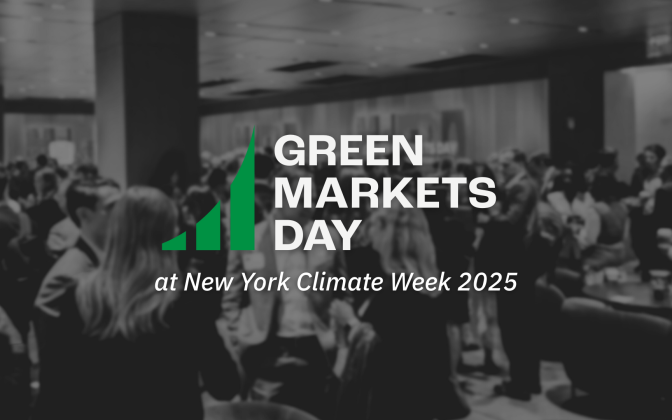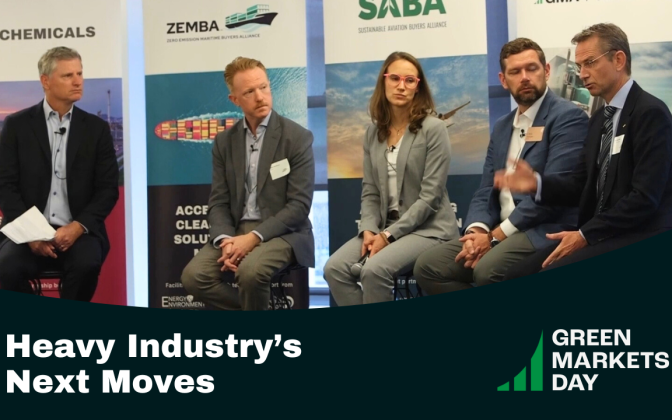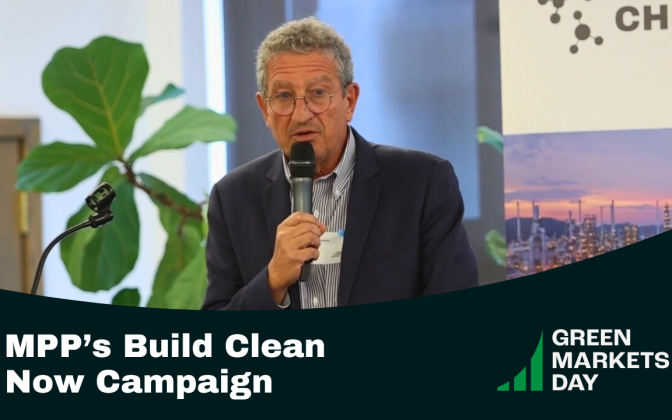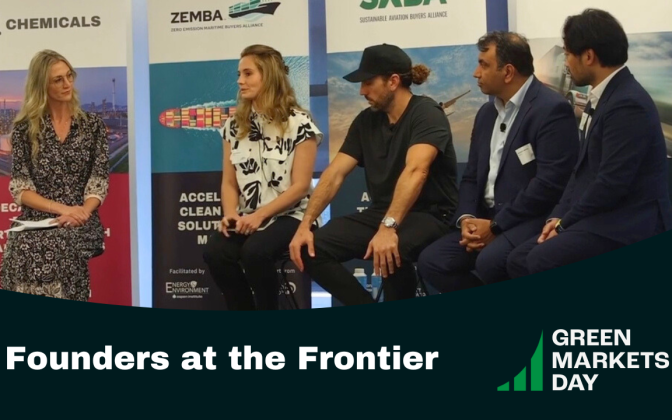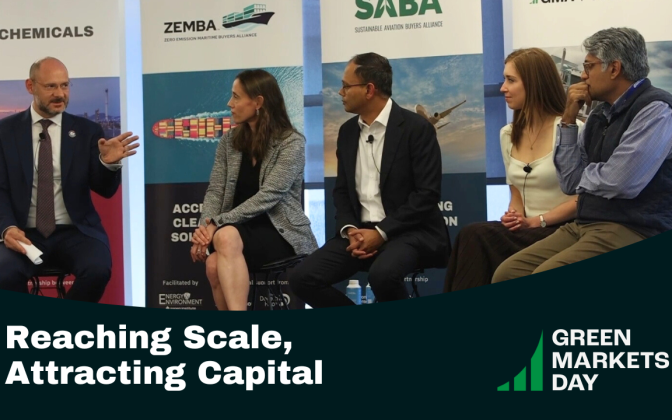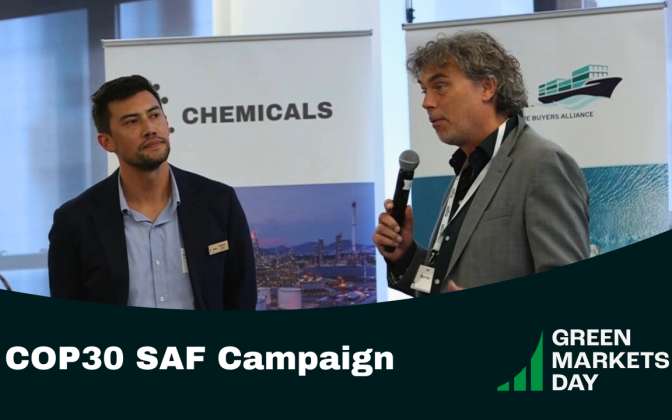10.29.25
Green Markets Day 2025 – Reaching Scale, Attracting Capital
In this panel discussion during Green Markets Day 2025, moderator Paul Bodnar, Director of Sustainable Finance, Industry, and Diplomacy for the Bezos Earth Fund, is joined by Laura Hellman, Senior Vice President at Brookfield, Brandon Middaugh, GM/Partner, Sustainability Markets and Innovation Fund at Microsoft, Rama Variankaval, Global Head of Corporate Advisory and Sustainable Solutions at JPMC, and Jigar Shah, Co-Managing Partner at Multiplier.
See below for a full transcript.
PAUL BODNAR:
My name is Paul Bodnar. I represent the necktie industry.
Actually, I’m the Director of Sustainable Finance, Industry, and Diplomacy at the Bezos Earth Fund. And it is my great pleasure to moderate a dynamo of a panel on the question of capital and how we bridge early-stage investment in climate hard tech and get to the point where we’re putting steel in the ground, often at billion-dollar scale.
So we’re going to be talking about that handoff between early stage venture funding and large scale capital deployment. We’re going to be talking about the market signals that trigger investors to move from pilots to deployment and figure out what are the models, the collaboration models among corporates, innovators, financiers, and sometimes governments that can make that possible.
So we’ve got a fabulous panel for you here to talk about that. Immediately here to my left is Brandon Middaugh, who is Senior Director of Microsoft’s billion-dollar Climate Innovation Fund, where she drives investments in breakthrough climate technologies and previously also led Microsoft’s Global Distributed Energy Strategy.
Then we have Rama Variankaval, who is the Global Head of Corporate Advisory at JP Morgan, overseeing teams focused on finance strategy, M&A structuring, climate transition, ESG, and infrastructure.
Okay, I need to pause after that one.
Laura Hellman is Senior Vice President at Brookfield Asset Management, which, as you all know, is one of the largest investors at scale in our space. And she specializes in transition and renewable energy investments and will tell us about a very exciting deal that she led last year, I believe.
And last, maybe not least, Jigar Shah. Could be least, we’ll see. Co-managing partner at Multiplier, LLC, a clean tech advisory firm. But you may know him from his podcast, Open Circuit. And he previously led the US Department of Energy Loan Programs Office, deploying $108 billion for clean energy and transportation projects, founded SunEdison, co-founded Generate Capital, launched the Carbon War Room.
So what better group could we have for discussing this interesting topic? So first we’re going to talk about getting from zero to one and how we get from venture, which we’ve talked a lot about here recently, to large-scale infra. And of course, we talk about the valley of death. There are probably several little valleys of death in that larger valley of death between early-stage pilot funding and deployable scalable financing.
So I’m going to ask each of you from your vantage point and experience, what are the biggest obstacles blocking capital from flowing across that gap?
And Jigar, I’m going to start with you. You had this amazing experience overseeing LPO. Tell us what you saw, because this was your job, was to deploy capital at scale. What did you see? What was the bridge that you tried to build? What went right, what went wrong? How should we think about this problem more generally?
JIGAR SHAH:
Well, I think when you have a working public-private partnership, I do think that there is a major role for coordinating across private sector and public sector and figuring out how you do big things, right? I mean, in our case, it was providing low-cost debt to get to much higher, more stable returns for the equity because we were patient capital, right? So we weren’t going to seize control of the assets. We weren’t going to figure out how to foreclose on the assets. The goal of the US government is to have these technologies actually stay here, employ people here, right? Scale up here, right?
I think that, but when I left office, I talked to over 120 companies, right, that weren’t in front of the Loan Programs Office, but just, are great companies. And a lot of what I heard from people is that I think a lot of what we’re doing wrong right now in our sector is figuring out where the right time is to exit. So I think there is a laziness in our sector around trying to copy tech models. And it doesn’t work, right? Whether it’s SaaS or whether it’s whatever it is, like our models don’t have the same trajectory.
And so what you find is that the seed stage and the A stage folks, I think, are doing a good job and they’re identifying companies and giving them cash. But a lot of these companies actually just need to be sold after the A round, right? Once you achieve product market fit and once you’ve got like two great customers, like you sort of need to be a part of somebody’s catalog, right? You go into Schneider, you go into Siemens, you go into whatever else, it’s $75 million.
And what’s happened recently is I think a lot of folks have raised all this money because their venture capitalists want to give them more. And then they’re priced out. The people who would buy them are like, we’re not going to pay $500 million for you. And so suddenly, they’re priced out of the market. They’re unlikely to be a publicly traded company because they’re not actually in charge. They’re a single point solution.
And so we’re in this weird spot where I don’t think we’ve done enough soul searching around that valley of death, right? Part of the valley of death is that there is no valley of death if you’re part of a large corporation who sees it as their strategic mission within their– their, like, actually catalog management in this moment. There is a valley of death if you’re an early stage company who now needs to get $100 million and now needs to burn capital for another three years to get to that next level of success.
And so part of what we’re doing at Multiplier, but also like I’m doing broadly, is investigating what that looks like and how we get entrepreneurs better exits, which oftentimes could be earlier in the process.
PAUL BODNAR:
Does that mean you think there needs to be more corporate M&A? Because most of the companies are not destined to just go public as freestanding entities?
JIGAR SHAH:
Yeah, I mean, almost all of the companies are not destined to be freestanding entities. I think when you look at the vast majority of these companies, right, they… like fix HVAC or they fix like this. I mean, even like companies who have gone public, like Nextracker, you’re looking at them and going, should they be independent companies, right? Or should they be part of a larger conglomerate of manufacturing companies, right?
I just think that when you think about how these things work, you know, like I think that we just all just default into whatever the tech, like sort of supply chain, you know, sort of value chain looks like. And I don’t think that works for our businesses.
Some of the things I learned at the Loan Programs Office is the folks who were the best investors in our projects were strategics, right? Like the Koreans and the Japanese companies, others. Why? Because they didn’t care about the return on those particular investments. Like what they cared about is being in the beginning stages of a transformational technology. And if it worked here, they could take it back to Korea or Japan and really scale it up and make it a multi-billion dollar business, right?
And for a lot of our growth equity funds, et cetera, I mean, they have to demonstrate 20 plus percent return investment to their LPs, which these projects may or may not be able to do.
PAUL BODNAR:
Great. Ram, I’m going to turn to you on this. Given that your mandate, you have a mandate that focuses on climate and transition, but you have this broader corporate M&A mandate. What do you think of this problem and what are the solutions?
RAMA VARIANKAVAL:
Luckily, we do both M&A and IPOs. I’m indifferent.
I think, again, I’m going to take the easy way out and agree with Jigar, mostly. Some companies, I agree, 100% are just really outsourced R&D department. That’s what it is. They should realize that that’s all they are. They’re outsourced R&D for some other large corporate. Their destiny is to just fulfill that role and then become part of large corporate, 100%.
The one maybe additional point I will say is there are such things as business cycles, and we are in the trough. I don’t think we have to be patient. There is nothing we could do. There was a 10-year period when money was free and everything could be funded, and we funded everything, right?
Now money is not free, and we are in a different part of the cycle. Risk premiums are a little higher, especially for very long duration cash flows. The discount rate is higher. It’s just the valuations don’t look great. A lot of VC and private equity sponsor companies, even away from climate, are struggling for exits, right? Because the vintage was 2019, 2020, 2021. Those valuations might be very hard to replicate now and to deliver returns to LPs, exactly as you said. So, and that’s a cyclical issue. I think we will get out of it. We need to be patient.
And there is this kind of identity crisis, right? Is this a SaaS business model? Some might look like it. And a lot of people started kind of, a lot of climate tech look very SaaSy. And I think those businesses, I’m personally…
JIGAR SHAH:
You were very sassy.
RAMA VARIANKAVAL:
I didn’t really, you know, not a big fan. Exactly.
And some are really infrastructure businesses, but they require so much capital that the venture community is just not the right place. And for banks to step in, we need offtake. There isn’t really any other, nothing else works. If you don’t have a customer who signed a contract with you, don’t bother coming to us. There’s just nothing we could do. We’d like to help, but there’s nothing we could do.
PAUL BODNAR:
Go ahead.
RAMA VARIANKAVAL:
The best people to sign off take? Microsoft. We love those off takes.
PAUL BODNAR:
The only people…
BRANDON MIDDAUGH:
Today we put out our mid-decade market development paper, and it highlights technology demand and capital as the core elements of the flywheel, and then you can make it go faster with other things, policy accelerants and so on.
But I think that what you raise about the venture and growth challenge of exits today, there’s an analogy in infrastructure as an asset class as well, which is we’re all of us spending this week talking about this very specific tranche of capital, stage of capital, and how you solve for that. And for the entities that are ready to step into that space, I think, you know, especially if there’s an out of market risk element, you know, and you’re going beyond a pure risk adjusted return calculation, one of the things that’s needed is an opportunity to recycle that capital and early exit.
So I would say take out finance on the infra side would be my answer to your question, which is once something is partly or largely de-risked and operational, how do you then pull that capital out and be able to put it back in earlier?
PAUL BODNAR:
Equity?
BRANDON MIDDAUGH:
It could be equity or debt. It depends on that. It depends on the entity you’re talking about. This is relevant for strategics, but also for the financial services industry.
And so I think from where we sit as both an investor and a buyer, it’s really important to create those tools for recycling the capital and those aren’t really used today, and they’re not really prevalent in the sort of infra and project space either.
I teed you up.
PAUL BODNAR:
So you have this great perspective. You took a brave new technology, and you got a billion dollar project to financial close.
LAURA HELLMAN:
A billion dollars is the total deal, which is the framework for future projects.
PAUL BODNAR:
Okay, well, so tells us how you got there as a commercial investor.
LAURA HELLMAN:
So I’m gonna approach this from the infrastructure lens because that’s really how we think about investments. And it’s hard to say what exactly, and there isn’t a single thing about the Roadrunner project that Infinium is constructing that like got us over the line per se. It is everything from fee stock agreements to advanced enough technology that was commercially operating and demonstrated, to advanced enough engineering, to the right project site.
Importantly, offtake. I think that for me, as somebody looking at that project, was a distinguishing factor. And we talk about offtake all the time, but it really matters, especially in these sectors that are still starting to scale up where we can’t sell SAF at jet fuel prices today. Everybody knows that, I think. So you need an off-take agreement that is at term and bankable with real counterparties.
And when we first started looking at Infinium, they had an off-take agreement. And there were other elements of the project that were close to FID, but not at FID. And they continued to be able to develop those. But it was exciting for us as investors to be able to be able to see a project that really looked like infrastructure. So that really allowed us to get over the line.
I think more broadly on this problem of valley of death, I think like the… They’re solving for the companies and how they’re going to raise capital and what their financing is and making it exciting for founders. And there’s also how do we build an ecosystem of projects that work so that we can deploy these at scale and build an actual industry? Because a couple of SAF projects is not going to make the SAF industry work. We need a lot of these projects developed.
And so I think whether it’s having a corporate fund everything past Series A and they give the development capital, or you raise through Series C and you’re able to finance the development capital that way, or you’re raising development loans, it doesn’t really matter. But as a developer and technology provider, you need to be laser focused on getting your project to look like an infrastructure piece that somebody can come fund with large scale capital. Maybe that means that it’s not on your balance sheet entirely, and you’re not funding your project through your Series C, D, and E.
PAUL BODNAR:
So can you tell us about the off-take piece then? How was that solved in this case?
LAURA HELLMAN:
Yeah, so I think the first off-take agreement that they got was with American Airlines and Citi.
PAUL BODNAR:
This is eSAF, just and a little E-Diesel and E-Naphtha, right? Okay, go ahead.
LAURA HELLMAN:
Did your homework.
PAUL BODNAR:
It’s a famous project.
JIGAR SHAH:
Paul stayed at the Holiday inn Express last night.
LAURA HELLMAN:
Yeah. exactly. And so that agreement is sold to American Airlines, and they’re selling the Scope 3 credits to Citi. And that is a partnership that helps finance the project.
We also have an offtake agreement with IAG, a parent company of British Airways. Like both of those were very helpful. And the American Airlines Citi one came first.
And so even though it didn’t cover the full volume of the facility, it demonstrated that there was a clear long-term demand at a fixed price.
PAUL BODNAR:
And OK, and how long is that off-take agreement?
LAURA HELLMAN:
Ten years.
PAUL BODNAR:
Ten years.
Well, just to put a plug in for some work that Rama and we did last year, which GMA was also involved in, there’s another mechanism, which is the market maker, which tries to solve this off-take problem. And the leading proponent of this has been a non-profit called H2 Global, which we fund at the Bezos Earth Fund. So if you’re interested in understanding how you can make a very muscular intervention in a market and create a pool of capital that serves as the buyer of first resort and the seller of first resort and bridges some of these tenor issues in off-take and price issues in off-take, look up H2 Global and the Green Market Maker model.
Just one more question on this round. So we started Jigar, with you saying we may have learned, like we’ve learned the wrong lessons from tech or other sectors. This sector is not like other sectors and we might do it differently. Why is it not like other sectors? How is it not like other sectors in relation to this particular problem we’re talking about?
JIGAR SHAH:
Because in the end, the upside is not infinite. Right, like when you’re working in something where you’re getting advertising dollars, right? I mean, that’s basically what all tech companies do, and then ultimately, like you’re in a greenfield space and your upside is infinite, that’s great, but in our space, like there actually is a price for Avgas. There’s a price for steel, there’s a price for cement, there’s a price for all the things that are up here, right? And so Brandon might be able to pay 2X the cost, but she’s not gonna pay 12X the cost, or if she does, it’s like a tiny, tiny amount of volume, right?
And so in the end, no matter what it is that you’re doing in our space, there’s only so much wealth creation that can be created by your innovation, right? And so then the question becomes, how do you stack the capital to make sure that everyone has enough room to make money, like within the value creation that is allowed for within the off-take agreements, right?
And at some point you need the cost of capital to be lower, right? Like that’s just it, right? And so then the question is, for that next round of capital that has a lower cost of capital, what do they want to see to get involved? Right, they might want to see product-market fit in the first two customers, they might want to see an off-take agreement, they might want to see a big pipeline of conversations, whatever it is they want to see, and then what you end up with is…
Sort of like a lot of companies, I mean, I don’t have to name them just because I don’t want to shame them, but there are a lot of friends of mine where they took a big slug of capital from Warburg Pincus, or they took a big slug of capital from this group or that group. And then they sold the company six years later. And guess what? The valuation for them personally was exactly the same six years later. And I was like, so you worked for free for six years? And they’re like, yeah, you know, that sucks. Right? That sucks, right?
And so they could have sold it six years earlier and then made it Warburg’s problem, right, to figure out how to scale that business to the next level. Or they become like a CEO of that entity that Warburg owns, right? They’ve already gotten a mini exit and now they have performance-based bonuses to meet whatever it is that company has to meet in terms of size and putting capital to work or whatever. But now their family like has their mortgage paid off.
I just think that in this space, like we have so for so long talked about doing well by doing good. And we have done so much good, and we have not delivered on the doing well part.
RAMA VARIANKAVAL:
It’s a combination of capped returns and need for very high quantum of capital. It’s a combination that kills the sector.
PAUL BODNAR:
Okay. Brandon, you mentioned something earlier that you’re both a buyer and an investor, right? So in some ways, I could see that it’s easier to be a buyer, you can say, well, if you build it, I will come. If you supply it, I will buy it. I’ll back these different sector efforts. But as an investor, how do you think about the difference between your role as a buyer, as a procurer, and as an investor in these technologies?
BRANDON MIDDAUGH:
In an ideal world, a corporation like Microsoft would be able to sign one of the bankable contracts that we were just talking for, for offtake. And then send that company, that counterparty to the banks. And in some cases, that works, and that is sufficient, especially in some de-risked sectors, or sectors where there’s a long history of institutional capital participation. We can talk about the JPM Chestnut Carbon as an example there.
I think in other emerging sectors, we have to be more involved in how we participate. And certainly in a lot of the work we’re doing on sustainable materials, sustainable fuels, it requires novel offtake contracts. We are both buying physical steel from Stegra, everyone see Johan afterwards, as well for our suppliers, as well as buying environmental attribute certificates for that. And we are an investor.
And so I think in some of these emerging sectors that you were hearing about in the sessions earlier, it’s really important for the strategics to get involved and have a high degree of alignment when they’re building out these novel contracting mechanisms.
PAUL BODNAR:
Would you guys like to talk for a minute about the Chestnut Carbon Project?
JIGAR SHAH:
You should, because it’s awesome.
RAMA VARIANKAVAL:
We love talking about Chestnut.
PAUL BODNAR:
Well, I just raise it because we just had a panel on, or we had a discussion about advanced market commitments. And the interesting thing about carbon removal, unlike some of the other commodities and sectors we’re talking about, is that these are demanded in the real economy, right? People need steel, they need cement, they want trucking services and aviation services and shipping services.
But carbon removal is tougher because it’s not a product that has a natural value in the real economy. So from an off-take perspective and from a valuation perspective, I imagine it was especially interesting for you guys.
BRANDON MIDDAUGH:
So do you want to go first?
RAMA VARIANKAVAL:
So carbon removal, CDR, a company called Chestnut, a project developer. Microsoft was the off-taker, a new 25-year off-take contract. And again, if you step back, pretty much all of these carbon removal companies or carbon companies are 100% equity financed, right? And the cost of capital issue is very, very problematic, so expensive.
So the idea was, how do we bring down the cost of capital? And again, we tried to take the project finance model and take this contract. And again, Microsoft and Chestnut were kind of to bring us in very early when they were still negotiating the contract so we could give suggestions on how to make the contract actually bankable before it was kind of pinged.
So we did that, and they did that really. We were kind of giving suggestions on how to kind of create the contract. And then again, several specific things again, twenty-five-year contract is fantastic. Microsoft as a counterparty is fantastic, but Chestnut itself is a very, very credible management team, owned by Kimmeridge, so we know that side as well. That was very important.
It was, again, the leverage ratio, the debt service was very healthy, so we did not overlever. There were a variety of project milestones. And so we tied our financing to all the milestones that Microsoft was demanding of Chestnut. And then we will sign more offtake if you buy more acreage or buy the seedlings. And we said, okay, we will release more funds when you do those exact same things.
So we were able to kind of connect those two things. And then just some characteristics of the project were very helpful. So I think spread over 8, the land is spread over 8 states, 7 or 8 states. So it helps us from kind of risk management perspective. There’s a fire, it’s not like the whole thing is going to go down.
We were able to convince some insurers to come in and provide us a backstop because there was some risk that Microsoft did not want to take, JP Morgan did not want to take. So we were able to kind of get insurance to take some of that risk.
So I think it’s fair to say we all kind of went a little outside our comfort zone. to make this work. And it’s only about $210 million of debt financing. And the only reason we spend months and all the time is because I think this is replicable. I think this sets a template for taking otherwise quite difficult to finance contract and make it financeable.
So we’ve been kind of quite actually interested, of course, the other big thing is we can’t just have CDRs as a trophy asset, or any of these things, Green Steel, SAF, it can’t just be a trophy asset that one or two guys want to buy. It has to be an asset everybody wants to own, right?
And Microsoft obviously is great, but we are talking to consumer companies, industrial companies, other tech companies. A number of people are now interested.
Now that there is the mousetrap of how to finance it and bring down the cost of capital, we’re getting a fairly good traction, I think.
BRANDON MIDDAUGH:
One of the things I love about the Chestnut transaction is the shared diligence. And I think that that is a generalizable function that I hope will be replicable across not just the carbon removal space, but some of these other sectors as well. Our teams do a tremendous amount of technical diligence, sustainability diligence, financial diligence, and so on, and to share that with a banking partner and then help that be part of what builds the bridge to bring them in. I think that’s something that’s really important as you’re looking at these sectors, too.
JIGAR SHAH:
I mean, the other thing that’s valuable here, though, is to Rama’s point and to Laura’s point, is it I mean, this is a really high quality team that have built like LNG assets, like natural gas assets, et cetera. They actually knew how to do a project in steel, which is great. And they got DBL to invest in to the round, et cetera, right?
And I think, and so like, I mean, one of the big challenges that I see right now is that there actually are like a certain number of teams that actually have this expertise. It’s actually not infinite. And it’s certainly not most of the 5,000 people who got venture capital since 2017.
And so part of the challenge is like, do we expect these teams to actually gain this knowledge? I doubt it. So then how do they rent this knowledge, right? And is that like strategic hires that they’re making that actually have this experience? Or are there like teams that they can partner with so the checklist that they’re pursuing gets to what Laura needs?
PAUL BODNAR:
So Laura, a question for you on this. Feel free to weigh in on this too. But as a big infra investor that’s done a lot in this space. What relevance do buyers alliances, advanced market commitments, and the sort of demand pull, demand aggregation side have for your willingness to underwrite deals?
LAURA HELLMAN:
It’s extremely important to have these associations. It is very, very helpful. And it sends the right signals to get the companies formed and starting to develop their technology. It gets early investors willing to fund the development capital.
Importantly, like these need to translate into bankable long-term offtake agreements as well, in order for the projects to fully get built if we’re talking hundreds of millions of dollars or a billion dollars on the line because nobody’s going to put up that money purely based on a market signal, but you need the market signal to get it catalyzed.
So it’s extremely important, but it also needs to come with real term offtake contracts and feedstock contracts, if that’s relevant. You need EPC contracts. You need the full thing to be infrastructure.
And one point you made that was super relevant and important is the replicability of these projects. We don’t spend the time looking at something to put $100 million into it and then call it a day. We’re spending time looking at scaling these technologies because we believe that there’s a path to scale them so that we can invest $1 billion or $2 billion and somebody else can do that and we can develop an entire industry. So you want to create something that can be done and is replicable.
JIGAR SHAH:
Well, I mean, to your point, the EBC contracts we reviewed hundreds during the Loan Programs Office, were in general in terrible shape every time we saw them. And it is another thing that I think Breakthrough Catalyst tried to bring some of that discipline into some of that. But I think it’s a huge problem.
And for some of the projects that we’ve had the most trouble with out of the Loan Programs Office, there were one-sided risks that the companies were taking that they didn’t really realize and ultimately didn’t have the quality construction team in-house to manage those risks. And so then when costs ballooned, they didn’t really know what to do about it and they couldn’t raise more equity. And then, the whole thing falls apart.
I do think that whole EPC thing is hard because we don’t actually have amazing EPC contractors in the US. Like we do from a solar and wind perspective. But like when you look at Kiewit or Mortenson or like some of these other companies, they’re not experts in building like monolith materials as OC1 plant or all these other things.
So you’ve got startups like Unlimited Industries that Andreessen Horowitz has backed to try to figure out a way to fix that, figure out how to get better feed studies, better cost studies, et cetera. But it is not a practice that we’re good at as a country in terms of actually getting proper EPC wrapped projects.
PAUL BODNAR:
Okay, I’m gonna ask you guys each the same question. I’m springing this question on you, and then if we have time for a couple audience questions, we’ll do that. When you think of, besides the projects we’ve mentioned, the Infinium Project Roadrunner and the Chestnut Carbon Project, what is a deal that you’ve seen recently that you find exciting in terms of how it’s trying to innovate and solve some of these financing or structuring problems? Who would like to go first?
LAURA HELLMAN:
Can I take an easy one and say the Stegra Deal is really exciting? The Stegra deal. Green steel. I’m excited about green steel and I think it’s… It’s been a market that needs to develop, and getting off-take contracts in the steel industry is very hard. And so I think it’s really creative.
BRANDON MIDDAUGH:
Yeah, and I’m happy to yes, and that one. I think that with Stegra, one of the interesting things was learning from other sectors. In carbon removal, we’re a large part of the end market, but in steel, we’re quite a small part of the end market. And so learning from the automotive sector on how to bring offtake contracts to bear in a very multi-layered supply chain is super interesting. This is a pair of offtakes where we’re combining both physical supply for the suppliers and then environmental attribute certificates and thinking about how those two combine to provide the bankability that Stegra needs in order to build their plant.
PAUL BODNAR:
And this is one of the first to do that, right?
BRANDON MIDDAUGH:
Yes.
PAUL BODNAR:
Yeah, okay, great.
RAMA VARIANKAVAL:
Slightly out of maybe scope, perhaps, is this deal with MP Materials? You heard of that?
PAUL BODNAR:
No.
RAMA VARIANKAVAL:
This is in the railroads magnet space. It’s a mining company, right? The only off-taker better than Microsoft that I know of is the U.S. government. We were representing MP Materials–
JIGAR SHAH:
So I’m just saying, MP Materials has never processed rare earths before. They’ve never made permanent magnets for it. No one is ever going to buy them. And we’re in this weird spot where we’re like celebrating…
RAMA VARIANKAVAL:
Jigar, these two agreed. We don’t have to disagree. You can agree with me.
JIGAR SHAH:
I’m just saying, like, we’re destroying the entire marketplace right now. Like, if you’re in the rare earths permanent magnet business, would you possibly want to compete with the US government right now?
RAMA VARIANKAVAL:
Well, the US government has always picked winners and losers. That’s something they’ve done.
But the point is finding an offtake. And again, MP Materials, right now there is obviously energy security is what sells. And if you are in the business of providing energy security, how will you define it? I think that is a massive advantage right now and there is a ton of capital. And again, I think MP Materials, whether you’re on the side of Jigar saying it’s a bad deal or not, it sets a template.
PAUL BODNAR:
What’s innovative about it?
RAMA VARIANKAVAL:
The US government provided an offtake and a price flow.
PAUL BODNAR:
For the entire volume?
RAMA VARIANKAVAL:
For the majority of the volume. And also provided, again, this is where I think Jigar is probably going, they provided essentially guaranteed EBITDA to the company. So that is, again, very generous. And maybe they will replicate it, maybe they won’t, but the idea is the US government cares merely about energy security, and there are lots of things in the critical mineral space, in the mining space, which I think would qualify.
PAUL BODNAR:
Sounds like a defense sector to you.
RAMA VARIANKAVAL:
I don’t think so. A lot of these are kind of used in climate tech, a lot of the input.
PAUL BODNAR:
Jigar, what would you nominate? MP material is taken.
JIGAR SHAH:
Yeah, I’ll definitely not be bringing that one up. Maybe I’ll do a little bit of a throwback.
I think, when I was at Generate Capital, we put several $100 million behind anaerobic digesters, right, and are now the largest food waste digester operator in the United States and Canada.
I think even with that work, which is one of the things I was talking to Dave Roberts and Clay about with my question, is it like, it sort of stalled, right? I mean, if you look at all of the industrial food companies in the country that have already made mandates to not put their food waste into landfills because of their scope 2 and scope 3 emissions, and they want it processed, we are short 40 digesters just for them to actually like, you know, process all of their food waste in Canada and the United States, right? I’m sure these guys would love to fund it. I’m sure lots of other people would love to fund it.
But even though we’ve got, like five or seven, of these already built, we’re not getting the next thirty built. Like those off-takes are not going into place, the construction’s not happening, the process is not happening.
LAURA HELLMAN:
The feedstock.
JIGAR SHAH:
The feedstock is already like the industrials have said that they want to take it somewhere. They’re not going to give you a 20-year feedstock agreement because they don’t know how much waste they’re going to have per year. But they’re like, we’re going to give you all of our spoiled ice cream or whatever it is that they give you, right? I know that the Generate Capital facility in Cayuga just like processed a bunch of mislabeled White Claws.
So I think that, but I think it’s something that I worry a lot about is that from the Loan Programs Office perspective, we did all these first of a kind deals, which I’m very proud of. But the point of it is actually to get to gigaton scale, right? The point of it is not to stop at five or seven units, right? And I worry that we’re not spending enough time thinking through. Like what’s causing these things to stall out after the first five or seven of them got built and NextEra bought the like, more dairy digesters and then BP bought more dairy digesters, et cetera. But like I think it’s stalled out now, we’re not—
PAUL BODNAR:
And why has it stalled out?
JIGAR SHAH:
I don’t know exactly, but I think that, but I think some of it is enthusiasm, right? So some of the industrial companies are like, well, I got 5% of my stuff into the thing and like I’ve checked that box and like it’s not clear that I actually want to like put a full-time person on getting it to 100%.
And some of it also could be like, crazy people in New York who listen to some crazy Cornell professor who hates all RNG, right? And so now we finally got that fixed last week, but it took seven years of work to fix that, right? Michigan, right, like some old Sierra Club person basically created a fake Facebook page, which then caused the digester to shut down prematurely.
And so like part of this is like there’s real risk, right? Like, I mean, you think about it as infrastructure for 25 years and like, and then something bad happens and then it creates a shadow over the industry, right? And so I just, like one of the things that I care deeply about is whether the stuff that we’re doing in the first five to seven plants like actually then scales to 100.
AUDIENCE MEMBER:
Can I come in on this one?
PAUL BODNAR:
Yeah, we’re just over time, but please do just.
AUDIENCE MEMBER:
There’s more– to connect back to the earlier panels, where you have offtakers who can’t get credit in the greenhouse gas system for the –
JIGAR SHAH:
Well, that’s right. The protocol, book and claim.
AUDIENCE MEMBER:
There are systematic issues, not just, it’s the things you talked about and more–
JIGAR SHAH:
Oh, totally. And what he’s talking about is the WRI led, well, it’s actually spun off now, but the Greenhouse Gas Protocols where the book and claim like process itself is now being, you know, like contested not just within that process, but like the entire government of Canada is now questioning book and claim, right, for their credit process, right? And you’re like, what are you doing? Book and claim by definition means you can’t double count it. They’re like, well, we’re not sure. And so it makes it difficult to figure out what the actual off-take agreements look like.
PAUL BODNAR:
OK, well, I’ll just close by saying that you mentioned spoiled ice cream, something that—
JIGAR SHAH:
That’s Unilever.
PAUL BODNAR:
Yeah, well, someone told me yesterday, just remember, institutional investors only like vanilla ice cream.
JIGAR SHAH:
So I don’t know, Paul, it’s a bit of a rocky road.
PAUL BODNAR:
All right, please join me in thanking the panel.




